|
|
|
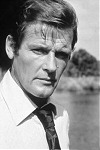 |
| |
MI6 trawls the archives to see how critics of
the day received Roger Moore's debut as James
Bond in
the 1973 film "Live And Let Die"... |
|
Time Tunnel: Review Rewind
21st February 2009
New York Times - June 28th,
1973
Torchlight, Voodoo drums. Dark bodies writhe in the mounting
frenzy of some unspeakable tropical rite. Suddenly a door is
flung open and framed within it stands a beautiful white girl
held captive by two monstrous black men. Her filmy white gown
scarcely covering the soft contours of her body, she is dragged — protesting — to
a crude scaffold and there is tied fast.
As if by signal, the ranks of jeering celebrants open
and there advances an executioner, laughing, stomping,
hideously costumed. He holds a poisonous snake in his outstretched
hands, a snake whose bite is destined for the smooth young
bosom.
Whatever the quality of this little scenario, you must
admit that to stick it into a movie these days takes nerve.
Merely to make a new adventure movie in which all the bad
guys are black and almost all the good guys are white,
and which includes in its climax the (near) sacrifice of
a (recent) virgin—takes nerve.
Nerve, and certain insolence toward public pieties, and
a lot of canniness about just what level of sophistication
its audience is up to—all of them qualities that
have characterized the James Bond movies since the beginning,
10 years ago, and that abundantly characterize the latest,
Guy Hamilton's "Live
and Let Die."
There are now eight Bond movies, and though they are the
work of many different talents (Hamilton has directed two
previously: "Goldfinger" and "Diamonds
Are Forever") they do represent a recognizable tradition
in which the whole—or the memory of the whole — seems
to be greater than the sum of the parts. |
|
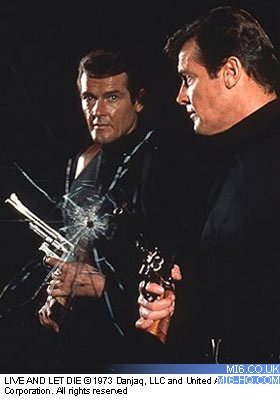
Above: One of the many special publicity
shots promoting Roger Moore as the new James Bond. "Live
And Let Die"
was the third consecutive 007 movie that had changed the
lead actor. |
The plots tend to flow into each other—one scheme after
another for controlling all the money in the world—changing
their elements to fit changing anxieties (in "Live and Let
Die" the evil is a heroin monopoly operating out of some
Caribbean island kingdom with pipelines into New York City and
New Orleans), but remaining the same in essence.
And always there is a woman waiting to be converted by the power
of sex. In "Live and Let Die" she reads the Tarot pack
to tell fortunes for the enemy. James Bond's card keeps coming
up "Lovers," though she thinks she is hoping for "Death."
There are three chases (four, if you stretch a point), including
one by car and motorboat that gets so complicated it allows for
character development. One actor, Clifton
James, who appears
only during the chase, gets fourth billing in the cast list.
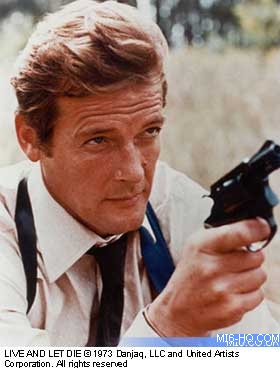 |
|
The names above Mr. James's
do not seem so impressive. Roger
Moore is a handsome, suave,
somewhat phlegmatic James
Bond—with a tendency to throw away his throwaway
quips as the minor embarrassments that, alas, they usually
are.
As Solitaire,
to whom the cards speak truth only so long as she remains
a virgin, Jane Seymour is beautiful enough,
but too submissive even for this scale of fantasy. Yaphet
Kotto (Dr. Kananga),
a most agreeable actor, simply does not project evil.
However, I could list compensating virtues by the score.
There is a marvelous escape from an alligator farm (deadly
reptiles are rather a motif in this movie), a superb collection
of grotesque ways of killing, and a fine sense of pace
and rhythm. "Live and Let Die" has been especially
well photographed and edited, and it makes clever and extensive
use of its good title song, by Paul and Linda McCartney. |
Variety - June, 1973
Live and Let Die, the eighth Cubby Broccoli-Harry Saltzman film
based on Ian Fleming's James Bond, introduces Roger Moore as
an okay replacement for Sean Connery.
The script reveals that
plot lines have descended further to the level of the old
Saturday afternoon serial.
Here Bond's assigned to ferret out mysterious goings on
involving Yaphet Kotto, diplomat from a Caribbean island
nation who in disguise also is a bigtime criminal. The
nefarious scheme in his mind: give away tons of free heroin
to create more American dopers and then he and the telephone
company will be the largest monopolies.
Jane Seymour, Kotto's
tarot-reading forecaster, loses her skill after turning
on to Bond-age.
The comic book plot meanders through a series of hardware
production numbers. These include some voodoo ceremonies;
a hilarious airplane-vs-auto pursuit scene; a double-decker
bus escape from motorcycles and police cars; and a climactic
inland waterway powerboat chase.
Killer sharks, poisonous
snakes and man-eating crocodiles also fail to deter Bond
from his mission. |
|
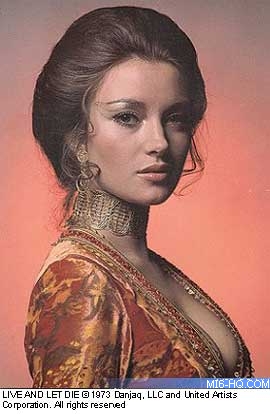 |
Time - July 9th,
1973
There is a new James Bond — Roger Moore of Sainted TV memory — and
a new angle to his latest adventure. In this incarnation, 007
is the Great White Hope. He goes about beating up black men who
are doing a little heroin smuggling to finance a Caribbean dictatorship
and, perhaps, take over the U.S. after they've turned
it into a nation of junkies with their free-sample program.
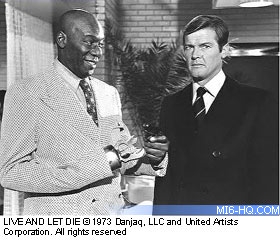
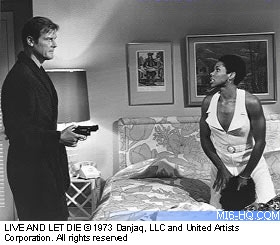
|
|
Both novelties are deplorable, and Live
and Let Die is the most vulgar addition to a series that
has long since outlived its brief historical moment — if
not, alas, its profitability.
Moore is afflicted with coolness unto death;
one half expects some plot revelation — a saliva
test, perhaps — to explain that the bad guys somehow
got him hooked before the picture started. None is forthcoming, so probably what we have here is
a case of belated fastidiousness: an actor trying to dissociate
himself from a project turning sour all around him.
As for Bond's new character
as a racist pig, there is a dubious rationale for it. Through
the years he has kicked and chopped his way through most
of the other races of man, so it could be argued that it
is just a matter of equal rights to let blacks have their
chance to play masochists to his pseudo-suave sadist. Not
surprisingly, this strained justification fails to relieve
the queasiness Live and Let Die induces.
Why are all the
blacks either stupid brutes or primitives deep into the
occult and voodooism? Why is miscegenation so often used
as a turn-on? Why do such questions even arise in what
is supposed to be pure entertainment? |
In part, the answers lie in the fact that the so-called entertainment
is never really entertaining. A couple of solid citizens, Yaphet
Kotto and Geoffrey Holder, are underemployed as an island dictator
cum pusher and his witchdoctor hireling while Jane Seymour, Gloria
Hendry and Madeline Smith are comely enough but curiously sexless
sex objects. They, like Moore, suffer a sort of weightlessness,
a lack of humanness, which is what Sean Connery as 007 lent previous
Bond adventures. The raunchy adolescent humor that helped audiences
giggle past the ugly inhuman stuff in previous Bond films like
Goldfinger and Diamonds Are Forever is rare and surprisingly
inept. The vehicular chases that have proved commercially successful
in other films are here rendered five times, which is four more
than any movie needs. Setting aside an allright speedboat spectacular
over land and water, the film is both perfunctory and predictable—leaving
the mind free to wander into the question of its overall taste.
Or lack of it.
Related Articles
 James Bond Time Tunnel James Bond Time Tunnel
 Live
And Let Die - Movie Coverage Live
And Let Die - Movie Coverage
|
|
|